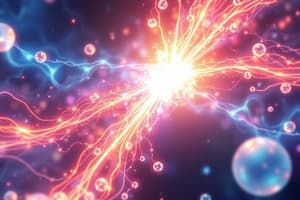Podcast
Questions and Answers
What is the term for the specific distance between bonding nuclei where the energy of the molecule is minimized?
What is the term for the specific distance between bonding nuclei where the energy of the molecule is minimized?
- Bond angle
- Bond order
- Bond length (correct)
- Bond strength
Which type of bond is formed when two atoms share three pairs of electrons?
Which type of bond is formed when two atoms share three pairs of electrons?
- Single bond
- Double bond
- Triple bond (correct)
- Quadruple bond
How does the bond length typically correlate with the strength of a bond?
How does the bond length typically correlate with the strength of a bond?
- Only depends on electronegativity
- No correlation
- Directly proportional
- Inversely proportional (correct)
What happens to the electron pair in a polar bond in terms of electronegativity?
What happens to the electron pair in a polar bond in terms of electronegativity?
Which bond has the highest bond energy according to the data provided?
Which bond has the highest bond energy according to the data provided?
What defines the existence of a chemical bond between atoms?
What defines the existence of a chemical bond between atoms?
What characteristic does an ionic bond exhibit?
What characteristic does an ionic bond exhibit?
How is lattice energy related to ionic compounds?
How is lattice energy related to ionic compounds?
Which of the following properties is NOT typical of ionic compounds?
Which of the following properties is NOT typical of ionic compounds?
In metallic bonding, what role do valence electrons play?
In metallic bonding, what role do valence electrons play?
Why are metals typically malleable and ductile?
Why are metals typically malleable and ductile?
What effect does the electronegativity difference have on bonding?
What effect does the electronegativity difference have on bonding?
What property distinguishes solid ionic compounds from their molten or aqueous states?
What property distinguishes solid ionic compounds from their molten or aqueous states?
Flashcards are hidden until you start studying
Study Notes
Chemical Bonding
- A chemical bond is an electrostatic force holding atoms together in a compound.
- A bond forms when the atoms are closer together than when apart, leading to a lower energy state.
- There are three types of bonding: Ionic, Metallic, and Covalent.
Ionic Bonding
- Ionic compounds have a three-dimensional lattice structure, with ions held together by electrostatic attraction.
- Electrons are transferred, forming cations (positively charged) and anions (negatively charged) ions.
- The strength of attraction depends on the size and charge of the ions.
- Larger electronegativity differences (typically >2) result in ionic bonds.
- Ionic compounds are often formed between elements from Groups 1 and 2 with elements from Groups 16 and 17.
- Lattice energy represents the strength of the ionic attraction, influencing properties like melting point, hardness, and solubility.
- Ionic compounds are typically hard, crystalline, brittle solids with high melting points.
- They do not conduct electricity as solids but can conduct electricity when molten or dissolved.
Metallic Bonding
- Metallic bonding occurs when elements have low ionization energies, allowing valence electrons to become mobile.
- This creates a "sea of electrons" surrounding the metal cations, holding them together.
- Metals are good electrical conductors in both solid and molten states.
- Metals are malleable and ductile because atoms can move past each other within the electron sea.
- Melting points vary, but are often relatively low as the electron sea maintains attraction between nuclei and electrons.
- Boiling points are typically high due to the strong attraction between the nuclei and electron sea.
Covalent Bonding
- Electrons are shared between atoms in covalent bonds.
- The bond length is the specific distance between bonding nuclei where the molecule's energy is minimized.
- A single covalent bond consists of a pair of shared electrons.
- Double bonds occur when two pairs of electrons are shared, and triple bonds involve three pairs of shared electrons.
- Lone pairs or non-bonding pairs are valence electrons that don't participate in bonding.
- Polar covalent bonds arise when the electron pair is attracted more strongly to the atom with higher electronegativity.
- The atom with higher electronegativity gains a partial negative charge, while the atom with lower electronegativity has a partial positive charge.
- There is an inverse correlation between bond strength and bond length.
- Stronger bonds generally have shorter bond lengths.
Studying That Suits You
Use AI to generate personalized quizzes and flashcards to suit your learning preferences.




